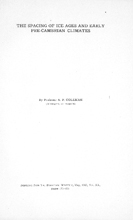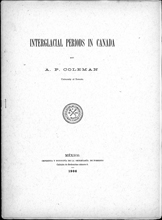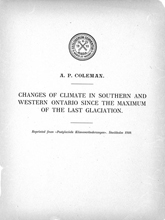Climate Change and Receding Glaciers
Alpine glaciers respond to climatic changes, as shown in their rhythmic advance and retreat in modern times, but in high mountains they do not disappear completely in warm periods, since by merely shrinking to higher elevations glacial conditions are retained, though on a smaller scale. From [t]his point of view the higher Rockies and Selkirks of the west are still in the Glacial Period and, the same is true of the Alps.
"Interglacial Periods in Canada," Proceedings.
10th International Geological Congress, Mexico City, 1906 : 26
Canadian Alpinists had been measuring the receding glaciers in the Rockies since the early twentieth century; scientists had been monitoring this phenomenon as well. Coleman addressed the issue in a lecture to the International Congress of Geologists in 1906 and much later in the 1938 'Presidential Anniversary Day" address to the Geological Society of America, "Ice Ages in the Geological Column."




